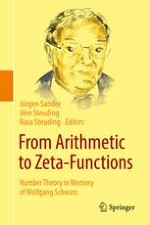2016 | OriginalPaper | Chapter
On Liouville Numbers: Yet Another Application of Functional Analysis to Number Theory
Author : Jörn Steuding
Published in: From Arithmetic to Zeta-Functions
Publisher: Springer International Publishing
Activate our intelligent search to find suitable subject content or patents.
Select sections of text to find matching patents with Artificial Intelligence. powered by
Select sections of text to find additional relevant content using AI-assisted search. powered by
